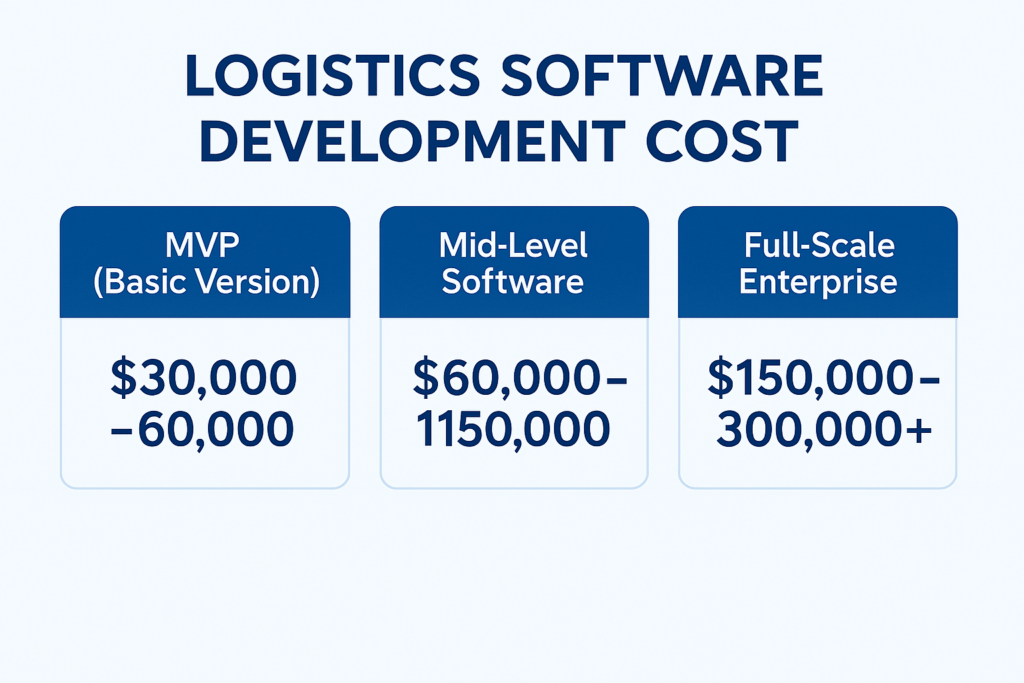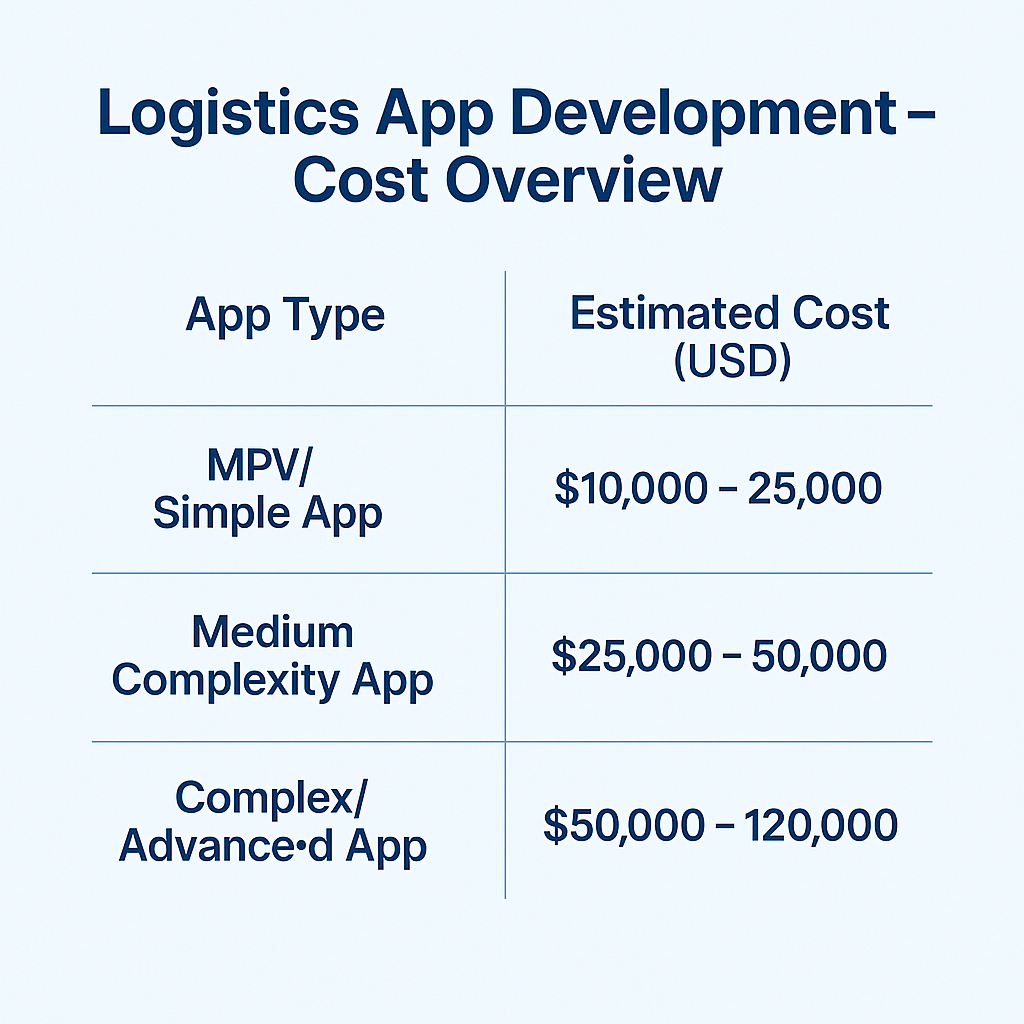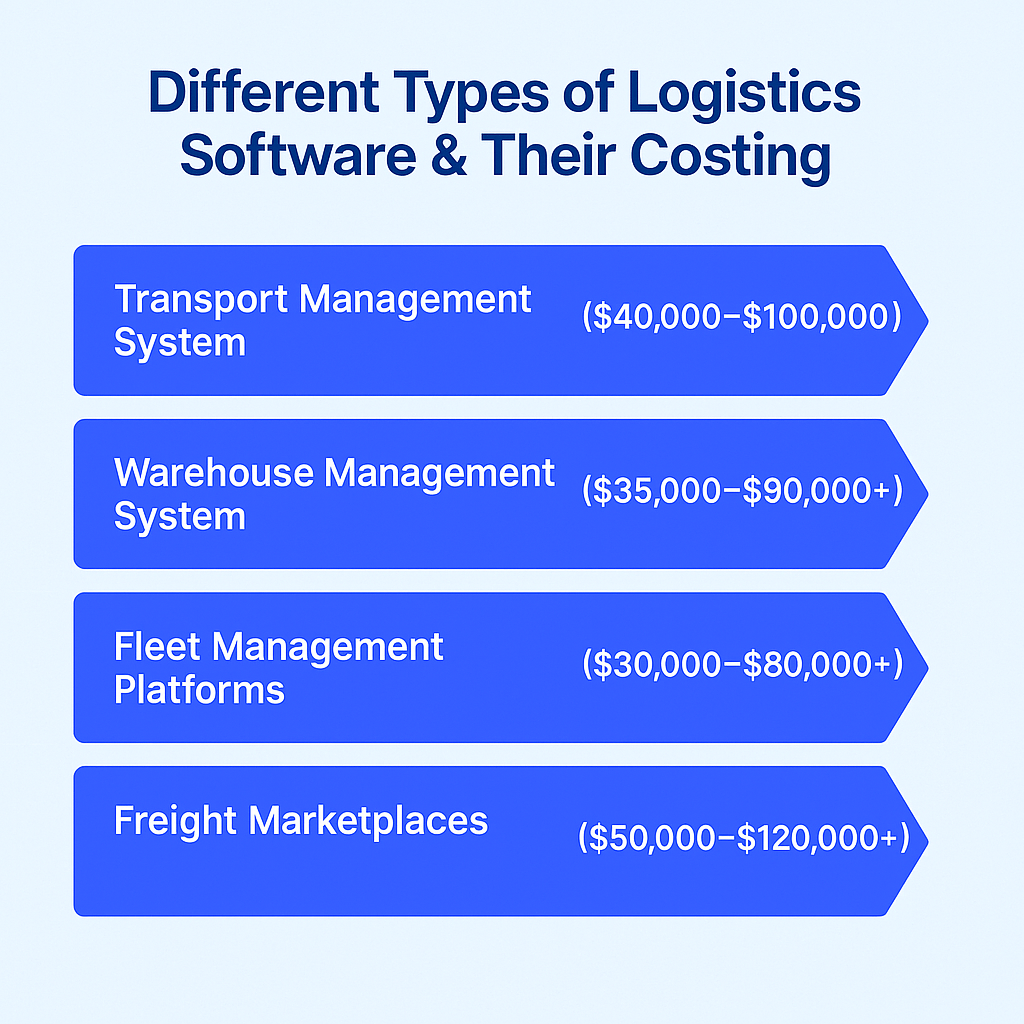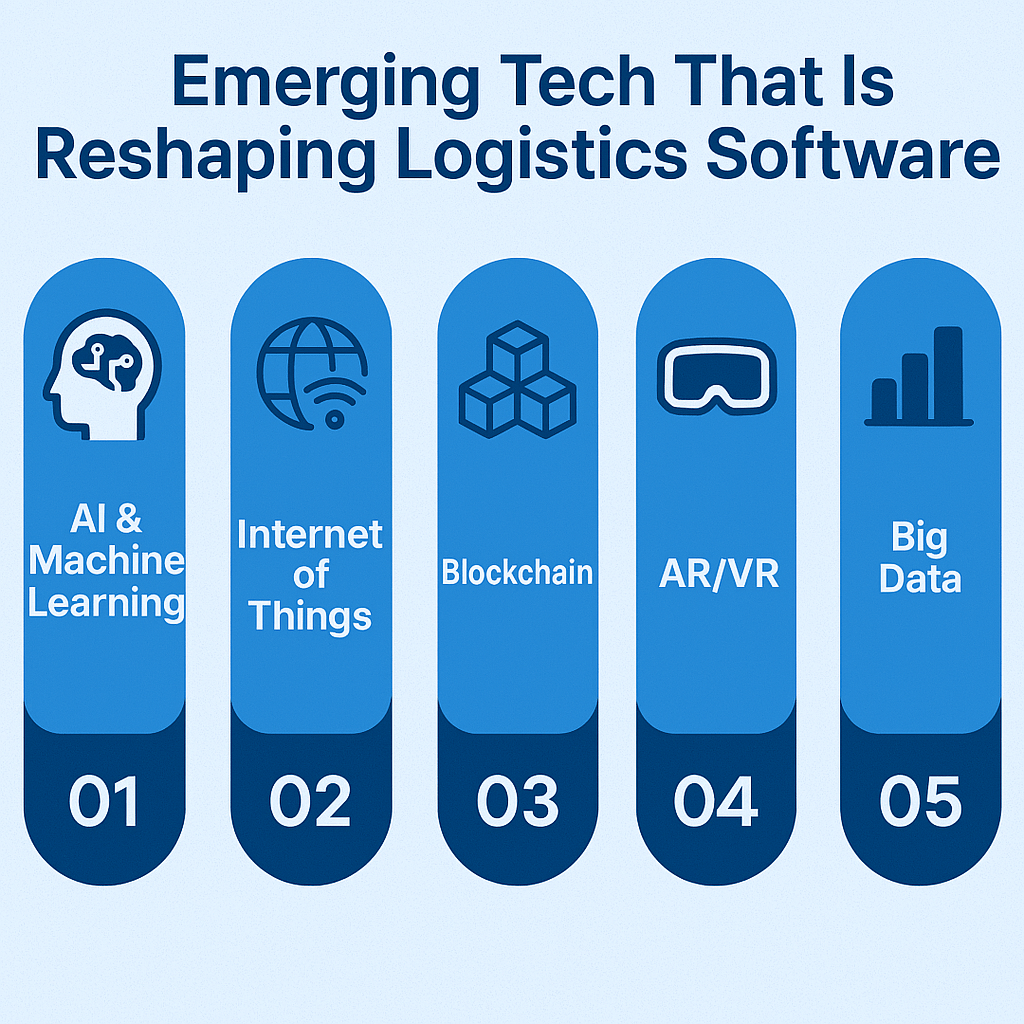The first question logistics startup founders and business owners ask is: ‘how much does it logistics software development cost?’
Let’s break it to you straight – logistics software development cost can range anywhere in between $30,000 to $300,000, depending on your region, scope and features.
Whether you’re building a warehouse management system, a fleet tracking software or a full-circle logistics marketplace – the costs can vary significantly. Studies suggests that an estimated 70% logistics companies are planning to invest in software development by 2026, making it an ideal time for you to grab that competitive edge and stay ahead of the curve.
If you’re curious to know the details, this guide highlights every aspect of the logistics software development cost – breaking down it to you in depth so you can make informed yet empowered investment decisions.
Ready To Build Your Dream Logistics Software?
Connect with our logistics software development experts today.
From exact cost of development and region-specific differences to the feature-centered expenses and the perfect tech-stack, it has everything covered for your ease.
How Much Does Logistics Software Development Cost?

The cost of logistics software development ranges in between $30,000 to $300,000, based on the following factors –
- Features selected
- Team location
- App complexity
- Tech stack and
- Type of logistics service you offer.
Here’s a straight-forward description of the logistics software development cost, based on these factors:
| Type of Software | Estimated Cost Range |
| MVP (Basic Version) | $30,000 – $60,000 |
| Mid-Level Software | $60,000 – 150,000 |
| Full-Scale Enterprise | $150,000 – $300,000+ |
While this only includes the cost of development, businesses must incur around 15-20% of the total cost as post-launch maintenance expense when accumulating.
MVP/Simple Logistics Software
An MVP/simple logistics software is usually built with basic features such as, order tracking, inventory management, and basic reporting. It ranges in between $30,000 to $60,000, depending on the platform you choose i.e. Android or IOS.
Medium-Complex Logistics Software
A mid-level logistics software carries slightly complexed features such as, barcode recognition. Real-time alerting, and third-party API integration. It can cost somewhere in between $60,000 and $150,000.
Advance Logistics Software
If you want an advanced logistics software with complex features such as, analytics dashboard, IoT integration, etc. – it would cost heavier, often in between $150,000 and $300,000 or even more.
Get Your Estimate & Start Now
Get a custom estimate for your dream logistics software & begin your development journey today.
Factors Affecting Logistics Software Development
There are multiple drivers that shape the cost of logistics software development, a few prominent among them can be described as follows –

Software Complexity
The more roles and modules such as, tracking, billing, dispatching, and integrations you wish to add, the higher will be the cost of development. Simple logistics software solutions such as a delivery software would involve less roles and modules leading to a lower cost while enterprise-grade solutions such as warehouse management software can have multiple modules and user roles.
Platform Type
Building a web-only? Or choosing cross-platform i.e. web + mobile n development? Well, this preference can also add up to the cost of development, with web-only software solutions being more cost-efficient than the other.
UI/UX Design
Enterprise software solutions that come with analytics, dashboard, role-based interfaces, and multilingual support demands solid designing, making almost 10-15% of the overall cost of logistics software development. The more personalized designs you require, the higher will be the cost. However, you must know that intuitive, smart UI/UX designs are key towards customer engagement and retention.
Third-Party Integrations
Advance-level logistics software development require third-party API integrations which certainly comes at a cost. The usual integrations such as, telematics, GPS,ERP, payment gateways, etc. cost an additional $5,000 – $20,000, which can accumulated into the total logistics software development cost.
Infrastructure
Secure cloud environments (Azure, AWS), databases (PostgreSQL, MongoDB), microservices, and CI/CD can take almost 20-25% of the total cost of software development. If you need adequate infrastructure that is secure as well as compatible with your business idea, you can expect higher costs but the investment will be worth the seamless experience.
Compliance & Security
An estimated 10-15% of the total cost of development is taken by the compliance and security efforts. It is important that your software solutions comply with industry regulations such as, GDPR, RBAC, transport regulations (FMCSA), and encryption laws, etc.
Team Location
The hourly cost of logistics software development varies from region to region. Therefore, the logistics software development team you partner with and their location will also contribute to the total development cost.
The hourly rates of developers in some major regions can be listed as –
- US/Canada: $100 – $200/hour
- Eastern Europe: $80 – $150/hour
- Western Europe: $40 – $70/hour
- South Asia: $25 -$50/hour
Region-Based Breakdown of Logistics Software Development Cost
If you’re curious about what it might cost to get a full-fledged logistics software developed in different regions, here’s an estimated breakdown for your ease –
| Region | Hourly Rate ($) | Estimated Software Cost |
| North America | $100 – $200 | $100,000 – $300,000 |
| Western Europe | $80 – $150 | $80,000 – $250,000 |
| Eastern Europe | $40 – $70 | $40,000 – $120,000 |
| South Asia | $25 – $50 | $30,000 – $100,000 |
| Southeast Asia | $20 – $40 | $25,000 – $80,000 |
Key Logistics Software Modules & Their Development Cost
A logistics software comprises of multiple modules – each of them built to fulfil the specific business requirements and user roles such as administrators, dispatchers, drivers, and clients. Here’s a very detailed breakdown of the development cost against each different module put together so you can strategize and budget without hassle.
Admin/Management Panel
It is the core of the overall logistics system meant to be used by the internal teams managing operations, vehicles, users, business intelligence and billing.

| Features | Cost | Functionality |
| Fleet & Vehicle Management | $6,000 – $10,000 | Tracks fuel consumption, vehicle location, availability, maintenance schedules, and telematics integration. |
| User Roles & Permissions | $3,000 – $6000 | Manage access control on the basis of roles like admin, dispatcher, driver, etc. |
| Reports & Analytics | $5,000 – $9,000 | Visualize and offer data-driven insights on delivery times, fleet usage, driver performance and revenue. |
| Billing, Invoicing & Finance | $4,000 – 7,000 | Automate payment reminders, client invoicing, and financial records along with integration of accounting tools. |
Dispatcher Panel
This panel is focused at the dispatchers and logistics coordinators, facilitating the seamless flow of deliveries, real-time decision-making and route assignments.

| Features | Cost | Functionality |
| Job Assignment Dashboard | $4,000 – $7,000 | Automated job assignment on the basis of driver availability, proximity, and job priority along with drag-and-drop interfaces. |
| Route Optimization | $5,000 – $9,000 | Integrates smart algorithms for reduced fuel consumption and delivery times, often integrated with HERE API, Mapbox or Google Maps |
| Notifications & Alerts | $2,000 – $4,000 | Automated sms, push and email notifications for job status updates, delays, and urgency alerts for drivers or customers. |
Client Portal (B2B/B2C)
This module is meant to empower your clients. Whether your logistics software is B2B or B2C, a rightfully built client panel can let customers have control over their orders and deliveries – offering a feeling of satisfaction even before they receive the orders.

| Features | Cost | Functionality |
| Order Management | $3,000 – $6,000 | Manages existing orders, submit new order requests, and keep track of delivery lifecycle from pickup to drop-off. |
| Real-Time Tracking | $3,000 – $10,000 | ETA updates and interactive live maps that offer dynamic tracking links ensuring 100% customer transparency. |
| Digital Proof of Delivery | $3,000 – $5,000 | e-signatures, photo capture, timestamp logging and QR scanning to ensure verified deliveries. |
| Self-Serve Reports | $2,000 – $4,000 | On-screen and downloadable reports showcasing expenses, delivery success rates, usage history and service metrics. |
Logistics App Development Cost – Key Overview
If you’re opting for a logistics app instead of a software, AppVerticals is a top-tier mobile app development company offering cost-effective yet robust solutions. Whether your focus audience uses Android or IOS, we offer the best android and iOS app development services – ensuring you receive an incredible outcome. To ease your hassle, we’ve put together a cost breakdown for that well so you can make an informed decision.

| App Type | Estimated Cost (USD) | Development Time | Key Features Included |
| MVP/Simple App | $10,000 – $25,000 | 2-3 months | § User login
§ Shipment tracking § Manual order entry § Admin panel § Basic notifications |
| Medium Complexity App | $25,000 – $50,000 | 3-5 months | § Route optimization
§ Real-time tracking § API integration § In-app messaging § Reporting & analysis |
| Complex/Advanced App | $50,000 – $120,000 | 6-9+ months | § AI/ML driven predictions
§ Advanced analytics & dashboard § Blockchain % IoT integration § Multi-language & currency support § Fleet and warehouse management modules |
While the above table only reflects the cost of logistics app development, you should also include an estimated 15-20% of the total cost as a post-launch and maintenance expense when accumulating the total budget.
Want A Detailed Breakdown Based on Your Specific Business Model?
Logistics Software Types You Can Build
The one-size-fits-it-all formula usually doesn’t work with logistics software. The solution you build majorly depends on the business model, needs and scale up to which you aim to expand. Thus, we’ve put together some of the most built logistics software along with their costing breakdown just so you can make strategic decisions.

Transport Management System
Purpose: to optimize operations such as planning, execution and delivery.
A TMS solution is solely built to optimize and streamline every stem involved in the movement of goods – from carrier selection and route planning to freight auditing and performance analytics. It helps 3PLs, logistics providers, and even large-scale shippers in reducing costs and enhancing efficiency.
Core Features –
- Real-time tracking & Route Optimization
- Load & Shipment Planning
- Freight Billing & Invoicing
- Carrier Rate Management & Selection
- Integration with GPS, ERP, and ELD Systems
Estimated Cost: $40,000 – $100,000+
Ideal For: medium to enterprise-level logistics providers, 3PL companies and freight forwarders.
Warehouse Management Systems (WMS)
Purpose: to streamline order fulfillment and enhance inventory accuracy.
WMS software are meant to control and optimize the day-to-day operations within a warehouse, helping manage the levels of stocks, picking, packing and shipping. They are crucial for the businesses that involve storing, sorting and dispatching of goods on a regular basis.
Core Features:
- Real-time inventory tracking
- Slotting & bin location management
- Barcode and RFID support
- Order picking, packing, and shipping workflows
- Returns and restocking modules
Estimated Cost: $35,000 – $95,000+
Ideal For: Fulfillment centers, e-commerce companies, and retail warehouses.
Fleet Management Platforms
Purpose: to manage and keep track of vehicle fleets handling delivery and transportation operations.
Fleet management platforms are meant to bring together tools that ensure each of your vehicle is performing efficiency, mining downtime, and staying compliant. Businesses that operate delivery and transport of their goods on their own can majorly benefit from a well-developed fleet management platform.
Core Features:
- Telematics & Diagnostics monitoring
- GPS-based vehicle tracking
- Maintenance scheduling & alerts
- Route history & mileage tracking
- Fuel consumption & driver behavior analytics
Estimated Cost: $30,000 – $80,000+
Ideal For: ride-sharing fleets, last-mile delivery companies, and courier businesses
Freight Marketplaces
Purpose: to digitally connect carriers with shoppers via listing or bidding platforms.
Freight marketplaces are often meant to digitize the booking and transportation freight by working as a central hub where brokers, providers, and truckers can negotiate and finalize shipments.
Core Features:
- Load posting and bidding system
- Carrier and shipper profiles with ratings
- Integrated payment and invoicing system
- Automated machine algorithms
- Real-time freight tracking
Estimated Cost: $50,000 – $120,000+
Ideal For: digital logistics startups, freights brokers, and freight forwarders.
Custom vs. Off-the-Shelf Logistics Software Solutions: Which One Is Better for Business Growth
While there are many off-the-shelf solutions available for logistics companies, choosing to build a custom software can always bring more value to your business. It can allow you to integrate features and functionality that aligns with your specific business needs, ensure industrial compliance and more – making it a worthy investment in the longer run.
Emerging Technologies Reshaping How Logistics Software Work
Logistics software is changing. It is evolving way beyond the basic tracking tools – becoming a smart ecosystem empowered by automation, real-time data, and predictive insights. The use of emerging tech is reshaping how logistics operate.

AI & Machine Learning – Intelligent Automation & Predictive Insights
AI and ML have become the foundation of logistics software – enabling faster yet smart decision-making.
- Predictive analytics help with forecasting inventory shortages, delivery delays, and seasonal demand shifts.
- AI-driven route optimization enhances delivery efficiency by optimizing fuel consumption, analyzing traffic and reducing delivery time windows.
- Machine learning algorithms help determine patterns in the supply chain data to enhance strategic planning, improve reliability and reduce costs.
Internet of Things (IoT) – Real-Time Asset Monitoring
IoT integration help logistics software manage and monitor their assets, fleets and facilities in real-time.
- Sensor and GPS tracking offer real-time updates around shipment conditions such as location, temperature, and tampering.
- Telematics enhance fleet maintenance by keeping close track of fuel usage, vehicle health and driver behavior.
- IoT-enabled warehouses allows automated inventory tracking, smart shelving, and restocking in real-time.
Blockchain – Transparent & Secure Supply Chain Networks
Blockchain is making logistics trusted amongst users by enhancing traceability and transparency within logistics software solutions.
- Distributed ledgers make sure every shipment, transaction and change in custody is recorded immutably.
- Smart contracts help automating custom clearances, compliances, and payment processing.
- End-to-end visibility helps with verifying provenance, reducing fraud, and ensuring regulatory compliance.
AR/VR – Enhanced Training & Virtual Oversight
AR and VR are changing how logistics teams used to interact with environments and systems by making experiences immersive and super engaging.
- AR interfaces assist warehouse personnel in picking, packing and restocking via visual instructions.
- VR Simulations offer safe yet scalable training for supply chain management and warehouse equipment operation.
- Remote facility inspections can easily be conducted via VR environments integrated into logistics platforms.
Big Data – From Raw Data to Strategic Action
The integration of big data capabilities into logistics software allow them unlocking powerful insights that help optimizing supply chains at best.
- Operational dashboards assist logistics managers in keeping a track of KPIs, bottlenecks and delivery performance in real-time.
- Demand forecasting models allow planning for capacity optimization and stock replenishment.
- Customer behavior insights help with optimizing and personalizing delivery preferences along with enhancing satisfaction.
Ideal Tech Stack for Logistics Software Development
It is crucial to choose the right tech stack in order to ensure that your logistics software is secure, fast, and scalable as well as easy to maintain. Here’s a detailed breakdown of what can be an ideal tech stack for your dream logistics software or maybe the top mobile app development technologies categorized on the basis of development layers.
Frontend (User Interface)
These include technologies the users usually see and interact with – be it an admin dashboard, customer tracking portal or a driver app.
| React.js | A popular JavaScript library that can help building a highlight responsive, single-page applications, and dynamic user interfaces. Ideal for logistics dashboards. |
| Flutter | A cross-platform UI toolkit by Google that can serve perfectly in building native apps with a singular codebase. Perfect for driver/courier apps. |
| Angular | A dynamic front-end framework that can be ideally suitable for enterprise-grade web apps that require component-based architecture and complex workflows. |
Backend (Server-side Logic)
These are meant to handle the core logistics operations such as user authentication, database interactions, notifications, and business rules.
| Node.js | Scalable and lightweight, ideal for real-time operations such as notifications, tracking, and PI-heavy logistics systems. |
| Django (Python) | Ideal for strong activity, rapid development, and data-heavy systems like TMS and ERPs. |
| Ruby on Rails | Popular for its convention-over-configuration approach, best for quicker development cycles and startups that are building freight MVPs and marketplaces. |
Databases (Data Storage)
Meant to store and manage key logistics data such as fleet data, shipment records, user information, and inventory.
| PostgreSQL | A profound open-source database, best for handling structured logistics data and queries e.g. invoices and routing, etc. |
| MongoDB | A NoSQL database that can serve perfectly for storing semi-structures and unstructured data like geolocation feeds, logs, and real-time tracking. |
| Firebase | It is a great NoSQL cloud database by Google, perfect for real-time, lightweight features in mobile apps e.g. chat between dispatch and drivers. |
Cloud Services (Hosting and Scalability)
Cloud platforms allows higher availability and scalability, as well as tools for the deployment and traction of your logistics software or application.
| Amazon Web Services (AWS) | It is a widely used cloud provider that offer services like S3, EC2, Lambda, and more. |
| Google Cloud Platform (GCP) | Often preferred by the developers for powerful analytics, Firebase backend support, and AI/ML integrations. |
| Microsoft Azure | Trusted by multiple enterprises for easy integration with hybrid cloud setups and Microsoft’s suite. |
APIs and Integrations
Third-party APIs can help accelerating development and offer essential features like messaging, payments, maps and user verification.
| Google Maps API | For route optimization, geolocation, real-time map views, and distance calculation. |
| Stripe | A developer-friendly yet secure payment gateway that helps handling subscriptions, freight billing and commissions rightly. |
| Twilio | It simplifies sending SMS alerts, real-time notifications, and driver-customer communication. |
| SendGrid | Best for automated transactional emails like shipment updates, order confirmations, and invoices. |
Every Day Delayed = Opportunities Lost
Start today. Let’s map your ideal timeline and logistics software development cost.
How to Scale Your Logistics App
Scaling your logistics software sounds like fun, right? Adding new features and enhancing user experience – all that promises a potential business growth? Well, that absolutely does but it does bring around a lot of other aspects such as, refining performance, improving usability, and ensuring you’re all set for an increased demand.
Let’s look at the key tactics you can utilize to scale your logistics software:
- Refine the user workflows for drivers, warehouse staff, dispatchers and admins. Make your dashboards simpler, minimize friction, and automate routine tasks for a better order processing and enhanced decision-making.
- Integrate features as of real-time support inside your platform. Whether its AI chatbots for partners and drivers or live chat for business clients, instant help can build trust and minimize operational downtime.
- Combine your software with powerful CRM platforms to enhance lead management, customer engagement and upselling. Meanwhile, analytics dashboards can help revealing delivery delays, inefficiencies, and performance KPIs.
How to Monetize Your Logistics Software
The monetization model you inculcate can majorly influence your profitability and user experience. Here are some exceptionally well yet proven models you can work with –
- Freemium Model with In-app Upgrades
Offer core app features for free and charge against advanced tools such as, analytics, real-time tracking, and multi-user access, etc.
- Subscription Plans for Businesses
Tiered pricing on the basis of number of users, shipment volumes, and access to premium features. It is the best approach for B2B logistics software and tools.
- Commission-Based Revenue on Transaction
Earn a percentage against each shipment or delivery made through your platform – a common practice in the freight marketplaces.
- Ad Placements within the App
You can make money without charging the users directly by monetizing the traffic with logistics-related ads from fueling stations, insurance and fleeting services, etc.
- API Licensing for Third-Party Integrations
If your software solution offers logistics data and functionality (e.g. route optimization), you can license API access to external systems, partners, etc.
Pro-Tip: It is important to decide a revenue model before-hand because it will directly impact the development scope and scalability of your software as well as the logistics software development cost.
What Are the Top Challenges Faced During Logistics Software Development
If building a robust logistics software is your dream; you must also be aware of the hurdles and challenges that comes in between:
- Staying compliant with the latest regional and industrial regulations such as GDPR, transportation laws and industry-specific standards can be a hassle – especially when your dealing with fleet and user data.
- Logistics software are mainly dependent on the accurate time-tracking, instant notifications, and status updates, etc. Therefore, it is crucial to build and maintain a very reliable real-time architecture.
- With multiple logistics software emerging in the market, it has become difficult to bring differentiation. However, enhancing UX, integrations and focusing on a popular niche such as cold chain or last-mile can really make the difference.
Logistics Software Development with AppVerticals
Now that you’ve gone through the entire logistics software development cost breakdown, are you ready to embrace that digital transformation you’ve been wanting to? At AppVerticals, a leading mobile app development company with logistics software development as a core service, we build secure, scalable and high-performance logistics software tailored your specific business needs.
Whether you need a TMS, WMS or a custom end-to-end solution, let’s work together to turn your logistics challenges into competitive advantages.
Final Thoughts
Understanding logistics software development cost is a lot more than simple budgeting – it’s about making sure every dollar you invest brings value. By creating a feature-set that aligns with your user needs, making use of an ideal tech stack, and choosing the right monetization path – your software can deliver long-term growth and operational gains. Whether you’re launching a MVP or striving to help scale an enterprise – success only starts with clarity and strategic planning.
You Know the Cost — Now Unlock the ROI
With the right logistics software, your investment can turn into a long-term profit, growth, and efficiency.



